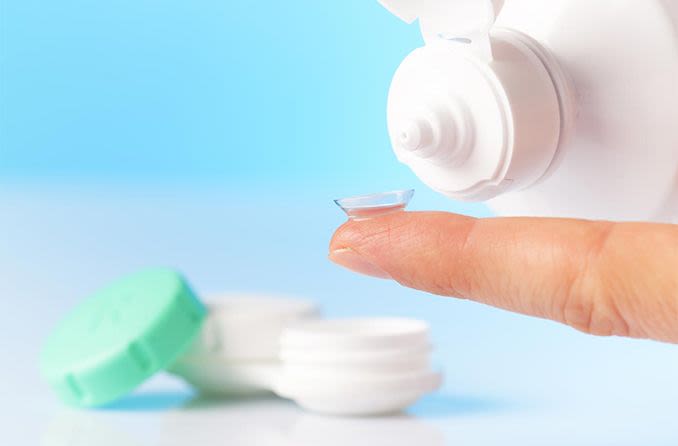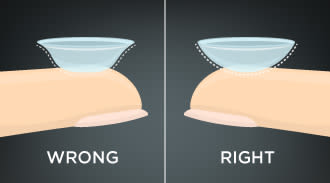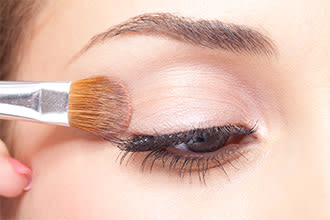How to use, put in and remove contact lenses

Many people new to contact lenses, and even some experienced wearers, have practical questions about wearing contacts.
Here are a few quick tips to help you with everyday contact lens concerns:
1. Is my contact lens inside out?
Sometimes it is difficult to tell if soft contact lenses have flipped inside out.

The difference can be subtle, but before placing a contact lens on your eye, make sure it looks like half a ball, not a soup bowl with a rim.
The trick is to place the lens on your finger so that a cup is formed. Then hold the lens up directly in front of your eyes so you're looking at the side of the cup.
If the lens forms a "U" with the top edges flared out, it's inside out. If it forms just a "U," it's in the correct position.
If you're wearing lenses with a handling tint, another way is to place the lens on your fingertip and then look down at it. The edge of a tinted lens should look very blue (or green, depending on the tint); that won't be the case if the lens is inverted.
Some contact lenses also have a laser marking, such as the brand name, on the edge to help you. If you can read it properly, the lens is not inside out.
Don't worry if you place a contact lens in your eye inside out. The lens will feel uncomfortable, but it typically won’t cause any harm to your eye.
2. Inserting Your Contact Lenses
Always wash your hands thoroughly before inserting your contact lenses. Avoid soaps that are scented or contain lanolin and moisturising lotions, which can adhere to your lenses.
Always begin with the same eye to avoid mixing up which lens goes on which eye.
Other basic guidelines for contact lens insertion include:
Gently shake your lens case containing the storage solution, to loosen the contact lens should it be stuck. (Don't try pulling at the lens with your finger, or you might damage it.)
Slide the lens out of its case and into the palm of your hand. Rinse thoroughly with the appropriate contact lens solution.
Place the contact lens on the tip of your index or middle finger, which should be dry or mostly dry.
With the fingers and thumb of your other hand, simultaneously pull up on your upper eyelid and down on your lower eyelid.
Position the lens on your eye while looking upward or forward, whichever you find easier. You can also apply the contact lens by placing it on the white of the eye on the side closest to your ear.
Gently close your eye, roll your eyes in a complete circle to help the lens settle, and then blink.
Look closely in the mirror to make sure the lens is centered on your eye. If it is, the lens should be comfortable, and your vision should be clear.
3. Removing your contact lenses
Always wash your hands before removing contact lenses. If you are standing in front of a sink, use a clean paper towel to cover the drain in case the contact lens accidentally falls.
To remove soft contact lenses, look upward or sideways while you pull down on your lower eyelid. With a finger, gently manoeuvre the lens onto the white of your eye. There, you can very gently pinch the lens together with your index finger and thumb and lift it off the eye.
Until you master contact lens removal, you might want to keep your fingernails short to avoid accidentally scratching and damaging your eye.
Gas permeable contact lenses can be removed by holding out the palm of your hand, bending over, and then opening your eye wide. With one finger of your other hand, pull the skin between your upper and lower eyelid (just outside the lateral aspect of your eye) outward toward your ear with your eye wide open. Then blink. The contact lens should pop right out and into your open palm.
For an alternative method, use a silicone device designed for removing gas permeable (GP) lenses that are sold online and elsewhere. These small, flexible devices have a tiny suction cup on one end. Gently touch this end of the device to the front surface of the GP lens and remove the lens from your eye. (Just make sure you touch only the lens and not your eye's surface with these devices.)
4. Eye makeup and contact lenses
Getting make-up in your eye is annoying but it's even worse if you are wearing contact lenses, because it can stick to or get behind your lenses instead of flushing out.
Follow these tips to avoid make-up-related contact lens problems:

Always put your contact lenses on before applying eye shadow, mascara and eyeliner.
Always put your contact lenses on before applying make-up and wash your hands thoroughly before touching your contacts, so you won't transfer any oils, creams or lotions to the lenses.
Only use non-allergenic make-up.
Cream eye shadow is less likely to get in your eye than powder. However, creams can irritate your eyes more if they do make it into your eyes. Choose water-based rather than oil-based creams.
If you prefer powder, keep your eyes closed during application. Then, brush off any excess powder before opening your eyes.
Never apply eyeliner between your lashes and your eye. Apply eyeliner only on the portion of your lashes that is well away from the surface of your eye.
To remove eye make-up, wash and dry your hands. Then remove your contacts, being careful not to bump them into any make-up. Finally, use your eye make-up remover.
Replace your eye make-up frequently — at least every three months. Don't use old eye make-up, because over time bacteria will get into the product and then into your eyes, where it can cause infection. One way to tell if your make-up is too old is if it smells odd. Also, don't share your eye make-up with others.
5. Contact lenses and UV radiation
Researchers have linked ultraviolet (UV) light to the formation of cataracts. Exposure to excessive UV light may also result in a condition called photokeratitis.
That's why some contact lenses now contain a UV-blocking agent.
You can't tell if a contact lens has a UV blocker just by looking at it — the blocking agent is clear, so as not to disturb vision. The contact lens packaging will specify if the product has a UV blocker, or you can ask your optometrist.
Very important: UV-blocking contacts are not meant to replace sunglasses. A contact lens covers only your cornea, not your entire eye.
Wear relatively large sunglasses with 100 percent UV protection to protect your eyes and the delicate skin around them from UV damage. UV-blocking contacts only provide limited supplemental protection for your eyes from the sun’s harmful UV rays.
Page published on Monday, 16 March 2020






